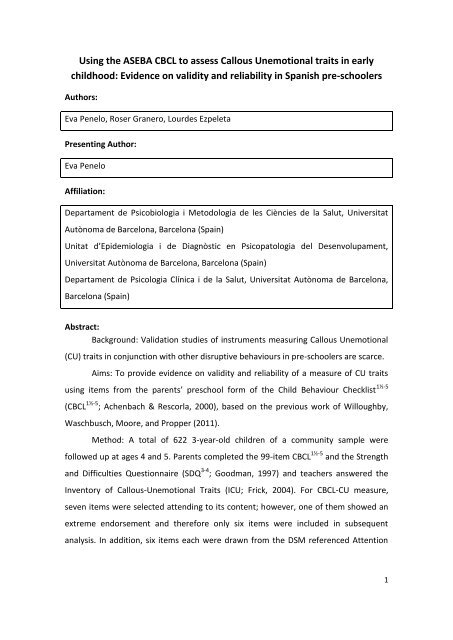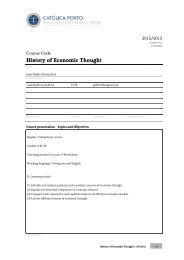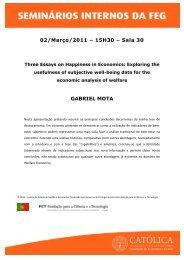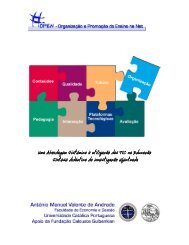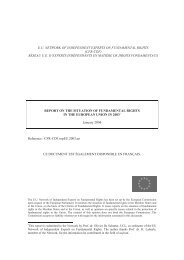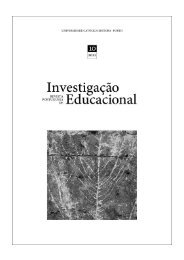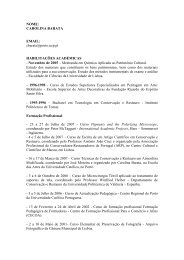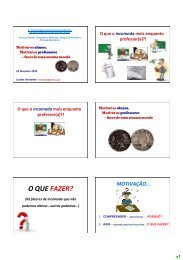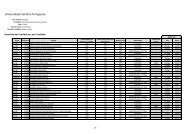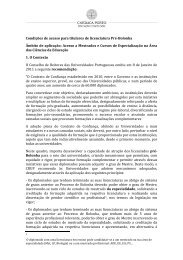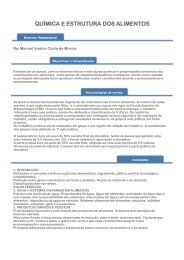Using the ASEBA CBCL to assess Callous Unemotional traits in ...
Using the ASEBA CBCL to assess Callous Unemotional traits in ...
Using the ASEBA CBCL to assess Callous Unemotional traits in ...
You also want an ePaper? Increase the reach of your titles
YUMPU automatically turns print PDFs into web optimized ePapers that Google loves.
<strong>Us<strong>in</strong>g</strong> <strong>the</strong> <strong>ASEBA</strong> <strong>CBCL</strong> <strong>to</strong> <strong>assess</strong> <strong>Callous</strong> <strong>Unemotional</strong> <strong>traits</strong> <strong>in</strong> early<br />
childhood: Evidence on validity and reliability <strong>in</strong> Spanish pre-schoolers<br />
Authors:<br />
Eva Penelo, Roser Granero, Lourdes Ezpeleta<br />
Present<strong>in</strong>g Author:<br />
Eva Penelo<br />
Affiliation:<br />
Departament de Psicobiologia i Me<strong>to</strong>dologia de les Ciències de la Salut, Universitat<br />
Autònoma de Barcelona, Barcelona (Spa<strong>in</strong>)<br />
Unitat d’Epidemiologia i de Diagnòstic en Psicopa<strong>to</strong>logia del Desenvolupament,<br />
Universitat Autònoma de Barcelona, Barcelona (Spa<strong>in</strong>)<br />
Departament de Psicologia Clínica i de la Salut, Universitat Autònoma de Barcelona,<br />
Barcelona (Spa<strong>in</strong>)<br />
Abstract:<br />
Background: Validation studies of <strong>in</strong>struments measur<strong>in</strong>g <strong>Callous</strong> <strong>Unemotional</strong><br />
(CU) <strong>traits</strong> <strong>in</strong> conjunction with o<strong>the</strong>r disruptive behaviours <strong>in</strong> pre-schoolers are scarce.<br />
Aims: To provide evidence on validity and reliability of a measure of CU <strong>traits</strong><br />
us<strong>in</strong>g items from <strong>the</strong> parents’ preschool form of <strong>the</strong> Child Behaviour Checklist 1½-5<br />
(<strong>CBCL</strong> 1½-5 ; Achenbach & Rescorla, 2000), based on <strong>the</strong> previous work of Willoughby,<br />
Waschbusch, Moore, and Propper (2011).<br />
Method: A <strong>to</strong>tal of 622 3-year-old children of a community sample were<br />
followed up at ages 4 and 5. Parents completed <strong>the</strong> 99-item <strong>CBCL</strong> 1½-5 and <strong>the</strong> Strength<br />
and Difficulties Questionnaire (SDQ 3-4 ; Goodman, 1997) and teachers answered <strong>the</strong><br />
Inven<strong>to</strong>ry of <strong>Callous</strong>-<strong>Unemotional</strong> Traits (ICU; Frick, 2004). For <strong>CBCL</strong>-CU measure,<br />
seven items were selected attend<strong>in</strong>g <strong>to</strong> its content; however, one of <strong>the</strong>m showed an<br />
extreme endorsement and <strong>the</strong>refore only six items were <strong>in</strong>cluded <strong>in</strong> subsequent<br />
analysis. In addition, six items each were drawn from <strong>the</strong> DSM referenced Attention<br />
1
Deficit/Hyperactivity Disorder (ADHD) and Oppositional Defiant Disorder (ODD) scales<br />
of <strong>CBCL</strong> 1½-5 .<br />
Results: Confirma<strong>to</strong>ry fac<strong>to</strong>r analysis with repeated measures at ages 3, 4, and<br />
5 of <strong>the</strong> 18 <strong>CBCL</strong> 1½-5 items selected showed that CU items could be dist<strong>in</strong>guished from<br />
ADHD and ODD items (RMSEA = .039, CFI = .902, TLI = .892), although <strong>the</strong> three fac<strong>to</strong>rs<br />
were highly correlated (r rang<strong>in</strong>g from .62 <strong>to</strong> .79). This 3-fac<strong>to</strong>r model yielded<br />
statistically significant fac<strong>to</strong>r load<strong>in</strong>gs (p ≤ .01) with standardized values above .30.<br />
Internal consistency for all scale scores was satisfac<strong>to</strong>ry at <strong>the</strong> three ages considered<br />
(omega ≥ .77). The one-year stability of <strong>CBCL</strong>-CU (r ≥ .56) was comparable <strong>to</strong> that of<br />
ADHD and ODD (r ≥ .65), whereas <strong>the</strong> two-year stability of <strong>CBCL</strong>-CU (r = .39) was lower<br />
than for ADHD and ODD scale scores (r ≥ .56). As expected, convergent validity<br />
between CU, ADHD and ODD <strong>CBCL</strong> 1½-5 scores rated by parents and ICU scale scores<br />
rated by teachers was moderated for ICU-callousness and ICU-uncar<strong>in</strong>g (r between .18<br />
and .32) and null for ICU-unemotional (r ≤ .13). <strong>CBCL</strong>-CU scores were related <strong>to</strong> SDQconduct<br />
problems (r ≥ .32) and SDQ- hyperactivity (r ≥ .35). Regard<strong>in</strong>g validity evidence<br />
based on an external criterion, CU scores satisfac<strong>to</strong>rily discrim<strong>in</strong>ated between <strong>the</strong><br />
presence and absence of oppositional and/or conduct DSM-IV disorder (OR ≥ 1.53,<br />
AUC ≥ .71).<br />
Conclusion: A CU dimension was identified based on items of <strong>CBCL</strong> 1½-5 with<br />
appropriate psychometric properties for use <strong>in</strong> early childhood. This measure derived<br />
from an <strong>in</strong>strument that is widely used and can be helpful for screen<strong>in</strong>g purposes for<br />
<strong>the</strong> <strong>assess</strong>ment of CU <strong>traits</strong>.<br />
Achenbach, T. M., & Rescorla, L. A. (2000). Manual for <strong>the</strong> <strong>ASEBA</strong> preschool-age forms & profiles.<br />
Burl<strong>in</strong>g<strong>to</strong>n, VT: University of Vermont, Research Center for Children, Youth, & Families.<br />
Frick, P. J. (2004). The Inven<strong>to</strong>ry of <strong>Callous</strong>-<strong>Unemotional</strong> <strong>traits</strong>. Retrieved from<br />
http://psyc.uno.edu/Frick%20Lab/ICU.html<br />
Goodman, R. (1997). The Strengths and Difficulties Questionnaire: A research note. Journal of Child<br />
Psychology and Psychiatry, 38, 581-586.<br />
Willoughby, M. T., Waschbusch, D. A., Moore, G. A., & Propper, C. B. (2011). <strong>Us<strong>in</strong>g</strong> <strong>the</strong> <strong>ASEBA</strong> <strong>to</strong> screen<br />
for <strong>Callous</strong> <strong>Unemotional</strong> <strong>traits</strong> <strong>in</strong> early childhood: Fac<strong>to</strong>r structure, temporal stability, and<br />
utility. Journal of Psychopathology and Behavioral Assessment, 33, 19-30.<br />
2


